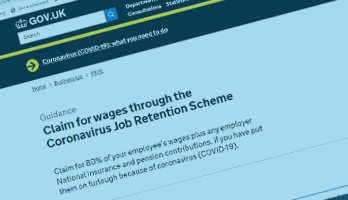CJRS in practice: What have we learned from the first two weeks?
 The Coronavirus Job Retention Scheme (CJRS), which allows private companies to claim money from the Government to cover employee’s salary costs during the COVID- 19 crisis, was launched on 20th April. The scheme allows employers to reclaim 80% of employees’ salaries up to a maximum of £2,500 per person.
The Coronavirus Job Retention Scheme (CJRS), which allows private companies to claim money from the Government to cover employee’s salary costs during the COVID- 19 crisis, was launched on 20th April. The scheme allows employers to reclaim 80% of employees’ salaries up to a maximum of £2,500 per person.
It is a massive undertaking and the Government and HMRC have been widely praised for getting it into place in such a short space of time. Inevitably though, such an immense project is bound to have teething difficulties and maybe even some deeper flaws.
What have we learned so far?
Several UK Training presenters have been involved in supporting many private clients to make claims through the CJRS and have identified some key areas of concern or interest, which are outlined below.
- Make sure you have all the information supporting your application to hand when you are processing the claim. If not, you may get timed out and will have to start again. The progress of applications is not saved on the system. Check the HMRC website to be sure about the evidence of your eligibility and expenditure that you need to provide. Some of these requirements have changed since the scheme launched so do check carefully.
- For those employing zero hours workers, most claims are based on averages and this is something else that can take a lot of time when collating the necessary information for submission.
- There is a lot of information on the landing page and many people had trouble locating the login button, which was actually labelled ‘continue with claim’ and tucked away at the bottom.
- Once you are logged in the claim process can seem slow as there are more than 20 screens to go through and for firms employing fewer than a hundred, employee details have to be entered one-by-one.
- There is no need to feel you must have submitted all your claims by 30th June because the portal will not close at that point. As yet, we do not know what the final date for submissions will be as we do not know how long the scheme will continue.
- There is no need to wait three weeks to make a new claim as long as the date of that new claim follows on from the date of the last claim that will be fine.
- If a new mother is returning from maternity leave you can pay them 80% of what they were paid before they went on leave. If they have gone part-time you can pay them 80% of the new contracted salary.
- If you realise there is a mistake in your first claim then you will be able to adjust it in later claims as it is unlikely there will be a technical solution to correct previous claims.
- The official HMRC guidance changed 6 times up to and beyond the actual launch date. If your first claim was based on working days (or a different interpretation) then do keep all the evidence as to why you made that decision and review whether that’s appropriate for your next claim. You may need to adjust the payment to furloughed staff upwards if the HMRC pro rata calculation is more beneficial than your own calculation was.
- Make sure you retain all the evidence for all the decisions on which your claim is based. The scheme represents a huge investment of public funds and we can expect HMRC to carry out detailed audits of claims during the next 5 years.
The Chancellor of the Exchequer, Rishi Sunak, has announced that the Government intends to begin withdrawing the scheme from July onwards, as lockdown measures are gradually lifted. The Treasury is considering several options for tapering the scheme, including reducing the wage subsidy paid by the state to from 80% to 60% and cutting the £2,500 cap on individual monthly payments.
UK Training’s payroll experts will continue to monitor the situation very closely. If you or any of your colleagues need to keep right up-to-date with payroll issues, you can book places on our Payroll: The Essential Update course here. If you need an understanding of the essentials of payroll processing or a more detailed course then we have a variety of courses available here.


